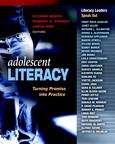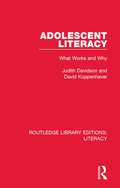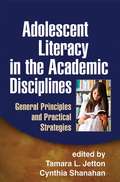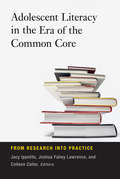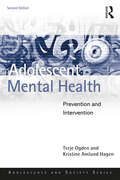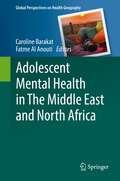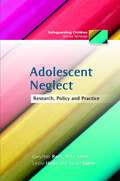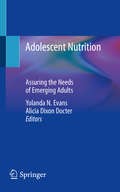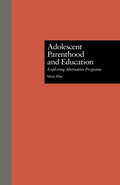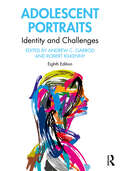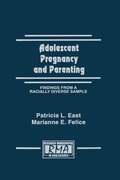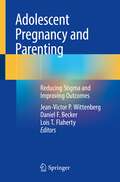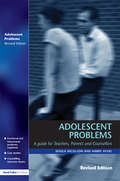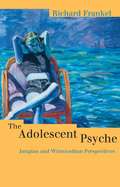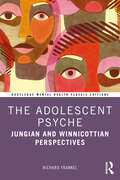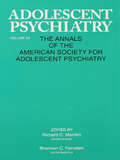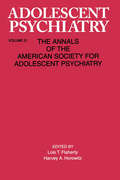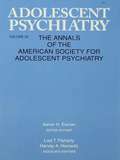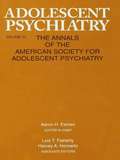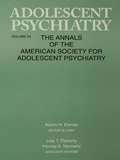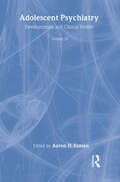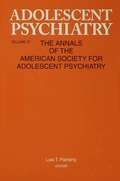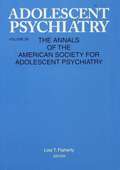- Table View
- List View
Adolescent Literacy: Turning Promise Into Practice
by Kylene Beers Robert E. Probst Linda RiefA handbook for middle and high school teachers, school and district administrators, and local, state, and national policy makers, on how to improve literacy instruction in all classes.
Adolescent Literacy: What Works and Why (Routledge Library Editions: Literacy #4)
by Judith Davidson David KoppenhaverOriginally published in 1988. Much has changed since then in schools. Mobile technologies, interactive whiteboards, digital texts, class websites, student-authored blogs, social networking and photo sharing sites found integrated into so many classrooms hadn’t even been imagined by most educators. What hasn’t changed, however, are the developmental needs of adolescents. A sense of competence, opportunities for creative expression, positive social interactions, and opportunities for self-definition remain centrally important. Similarly, print literacy (i.e., reading and writing with traditional orthography) continues to contribute strongly to academic success, employment opportunity, health, and life satisfaction. Consequently, this book remains very relevant today. Through case descriptions of literacy programs situated in formal and informal settings, the book draws attention to the ways that developmental appropriateness and engaging literacy instruction can assist all youth in reaching their full potential as readers and writers.
Adolescent Literacy in the Academic Disciplines
by Tamara L. JettonFrom leading authorities in both adolescent literacy and content-area teaching, this book addresses the particular challenges of literacy learning in each of the major academic disciplines. Chapters focus on how to help students successfully engage with texts and ideas in English/literature, science, math, history, and arts classrooms. The book shows that while general strategies for reading informational texts are essential, they are not enough-students also need to learn processing strategies that are quite specific to each subject and its typical tasks or problems. Vignettes from exemplary classrooms illustrate research-based ways to build content-area knowledge while targeting essential reading and writing skills.
Adolescent Literacy in the Era of the Common Core: From Research into Practice
by Jacy Ippolito, Joshua Fahey Lawrence, and Colleen ZallerAdolescent Literacy in the Era of the Common Core provides school leaders, teachers, and others with strategies and best practices for advancing adolescent literacy in the classroom. Exceptionally clear and accessible, the book addresses a full range of topics in this vitally important field, including disciplinary literacy; vocabulary instruction; classroom discussion; motivation and engagement related to digital literacy; the use of multiple texts; and writing to learn. This book presents &“usable knowledge&” of the highest order and of immediate value to school leaders and teachers. It will be required reading for all educators concerned with promoting and furthering adolescent literacy today.
Adolescent Literacy in the Era of the Common Core: From Research into Practice
by Joshua Fahey Lawrence Jacy Ippolito Colleen ZallerAdolescent Literacy in the Era of the Common Core provides school leaders, teachers, and others with strategies and best practices for advancing adolescent literacy in the classroom. Exceptionally clear and accessible, the book addresses a full range of topics in this vitally important field, including disciplinary literacy; vocabulary instruction; classroom discussion; motivation and engagement related to digital literacy; the use of multiple texts; and writing to learn. This book presents "usable knowledge" of the highest order and of immediate value to school leaders and teachers. It will be required reading for all educators concerned with promoting and furthering adolescent literacy today.
Adolescent Mental Health: Prevention and Intervention (Adolescence and Society)
by Terje Ogden Kristine Amlund HagenAdolescence is a period characterized by both increased susceptibility to risks and new-found strength to withstand them. Whilst most young people are well equipped to manage the changes associated with growing up, other maladjusted and marginalized adolescents already have, or are at risk of developing, mental health problems. Adolescent Mental Health: Prevention and Intervention is a concise and accessible overview of our current knowledge on effective treatment and prevention programs for young people with mental health problems. Whilst addressing some of the most common mental health issues among young people, such as behavioral problems and drug-related difficulties, it also offers a fuller understanding of the evidence-based treatment and prevention programs that are built upon what we know about how these behavioral and emotional problems develop and are sustained. The volume illustrates contemporary and empirically supported interventions and prevention efforts through a series of case studies. It has been fully updated in line with the latest NICE and DSM-V guidelines, and now includes an added chapter on implementation, and what factors facilitate implementation processes of intervention efforts. Adolescent Mental Health: Prevention and Intervention will be essential reading for students and practitioners in the fields of child welfare and mental health services, and any professional working with adolescents at risk of developing mental health problems.
Adolescent Mental Health in The Middle East and North Africa (Global Perspectives on Health Geography)
by Caroline Barakat Fatme Al AnoutiThis 2-volume set focuses on adolescent health in the Middle East and North Africa region (MENA), and presents the latest research on the health risk behaviours and social behaviours that adolescents from the MENA region engage in. While there has been a surge in peer-reviewed research publications on population health in the MENA region in the last couple of decades, very few books offer a resource to address the diverse negative influences that disproportionately affect adolescents and children in the MENA region, including increased tobacco consumption culture, low emphasis on physical activity, increased sedentary behaviours, weak health policies, and societal issues related to displacement and political conflicts. These books offer a synthesis of current knowledge on adolescent health issues in the MENA region, and aim to provide evidence-informed adolescent health care practices that address current issues related to mental, physical, reproductive and nutritional health. Volume 1 focuses on mental health in the MENA region, the development and implementation of youth friendly public policies, and how to strategize in the age of COVID-19. The study will aid health care professionals, policy makers, government organizations and health program planners to assess current policies and practices related to adolescent health in the MENA region, and to identify the best courses of action moving forward.
Adolescent Neglect: Research, Policy and Practice
by Sarah Gorin Leslie Hicks Mike Stein Gwyther ReesAdolescent neglect is a significant problem within child protection, but focus on child neglect and other forms of maltreatment means that it can often be overlooked. This book outlines how adolescent neglect differs from child neglect, the context of why it is overlooked, how it is defined, the causes and consequences of neglect, young people's views, and what professionals can do. Based on original research, the book establishes an evidence base and considers the implications for policy and practice. The concluding chapter sets out a practice-based framework for recognizing and working with adolescent neglect. Each chapter includes reflection points to stimulate thinking on key issues. This will be essential reading for all those who work with young people, particularly those in social work, health services and education, as well as academics, policymakers and students in these fields.
Adolescent Nutrition: Assuring the Needs of Emerging Adults
by Yolanda N. Evans Alicia Dixon DocterAdolescents have unique nutritional needs when compared to young children and adults. As youth go through physical, cognitive, and behavioral development, nutrition needs are dynamic and changing. If these needs go undetected and remain unaddressed, the results can derail physical and social maturation and include life-long effects on health. This comprehensive text offers a multidisciplinary perspective on aspects of adolescent nutrition. Using clinical cases, it covers relevant topics related to adolescent health including normal development, chronic health conditions, and complex biopsychosocial dynamics, among others. The first section of the text contains an overview of adolescent nutrition that is further broken down into more specific topics such as developmental nutrition needs, needs of active youth and athletes and media influences on body image. The next section focuses on health disparities such as culturally appropriate care, health equity, international considerations and food insecurity. The following section specifically addresses eating disorders ranging from anorexia and bulimia to binge eating. Finally, the last section covers additional health considerations such as polycystic ovarian syndrome, teen pregnancy, substance use and gender non-conforming youth. Written by experts in the field, this book is a helpful resource for primary care medical providers, registered dietitians/nutritionists (RDN), adolescent medicine specialists, as well as advanced practice nurses, physician assistants, psychologists, licensed social workers, and certified athletic trainers.
Adolescent Parenthood and Education: Exploring Alternative Programs (MSU Series on Children, Youth and Families #2)
by Mary PilatFirst published in 1997. Routledge is an imprint of Taylor & Francis, an informa company.
Adolescent Portraits: Identity and Challenges
by Andrew C. GarrodAdolescent Portraits introduces contemporary theories and research that surround adolescent development today through eighteen first-person accounts written by young adults. The case study approach of the book illustrates the complexity of the individual experience and the interactions among an individual’s needs, ideas, relationships, and context. Each case, taken alone, helps us begin to know one more adolescent and his or her experience; taken together, the cases provide a rich overview of the wide, diverse, and complex range of adolescent experiences. This edition also includes three follow-up essays, written five or more years after their original memoir. The authors of these follow-ups reflect on their original story written in late adolescence from the more mature point of view of full-fledged adulthood. These retrospectives provide a poignant and lifespan developmental perspective on the ways in which the adolescent themes of identity and challenges transform, for better or worse, with the tasks of adulthood. With contributions from adolescents from a range of racial, class, and family backgrounds, the book provides a diverse introduction to the adolescent experience. It is a must-read for any student of adolescent development.
Adolescent Pregnancy and Parenting: Findings From A Racially Diverse Sample (Research Monographs in Adolescence Series)
by Patricia L. East Marianne E. FeliceWritten by a pediatrician/adolescent medicine specialist and a developmental psychologist, this book is a collection of informative, nonredundant yet comprehensive studies on adolescent pregnancy and parenting. More than 200 adolescent women in an ethnically diverse sample were studied prenatally and at regular 6-month intervals for 3½ years postpartum. Most of the teens were poor, unmarried, first-time mothers who resided within Southeast San Diego, a poor urban area approximately 10 miles north of the U.S.-Mexico border. The purpose of this book was to offer researchers, practitioners, program directors, teachers, and graduate and medical students a better understanding of teenage pregnancy and parenthood within the following domains: * adolescent prenatal care and postpartum maternal and infant health outcomes, * immediate repeat pregnancy, * adolescent mothers' parenting, * the role of the adolescent's mother in teenage mothers' parenting, and * the baby's father.
Adolescent Pregnancy and Parenting: Reducing Stigma and Improving Outcomes
by Jean-Victor P. Wittenberg Daniel F. Becker Lois T. FlahertyThis book focuses on the impact of social stigma on adolescents who are at high risk of teen pregnancy. It describes and discusses personal and social factors that predispose them to becoming pregnant and having babies; factors that may subsequently protect or more often, compromise outcomes for both parents and children. The authors, who represent a range of social roles and perspectives, describe the pathways from stigma and its unfounded beliefs about disadvantaged adolescents, to the ways stress burdens teen parents and their children. They note that successful teen parents often go unrecognized and wonder how many more are hobbled by stigma. They recognize the lifespan impacts of stress as described in the ACE studies; stress that has psychological, health and economic implications at individual and social levels. They examine the impact of stigma on parent-child relationships and the attachment system, a stress management system, learned in infancy and persisting into adulthood. The book describes how stigma finds its way into daily interpersonal encounters, systemic policies and practices, and even into healthcare research and services.This sets the stage for an in-depth look at attachment systems within stress management, interventions, and recommendations for professionals whose work is impacted by these issues. Written by experts in the field, this text is the first to cover the current understanding of the risk factors, advanced understanding of developmental issues, and the key intervention tactics for the most positive outcome for adolescent parents and their families.Adolescent Pregnancy and Parenting is an excellent resource for psychiatrists, psychologists, physicians, social workers, educators, researchers, and policy makers working with youths at risk for teenage pregnancies.
Adolescent Problems: A Practical Guide For Parents, Teachers And Counsellors
by Harry Ayers Doula NicolsonFirst published in 1997, this book has been updated and revised to bring it in line with new legislation and current concerns. It is an eclectic reference book on adolescent emotional and behavioural problems, covering a range of psychological theories and approaches in a readable style. The theory presented is tied in with practical application using illustrative case studies and there are time-saving interview sheets and other material for teachers/counsellors to use.
The Adolescent Psyche: Jungian and Winnicottian Perspectives
by Richard FrankelAdolescence is recognised as a turbulent period of human development. Along with the physical changes of puberty, adolescents undergo significant transformations in the way they think, act, feel and perceive the world. The disruption that is manifest in their behaviour is upsetting and often incomprehensible to the adults surrounding them. In The Adolescent Psyche Richard Frankel shows how this unique stage of human development expresses through its traumas and fantasies the adolescent's urge towards self-realization. The impact of contemporary culture on the lives of young people has resulted in an increasing number of adolescents being referred for psychotherapy and psychiatric treatment. Successful outcomes are often difficult to achieve in clinical work with clients of this age-group. The advice and guidelines which Frankel provides will be welcomed by psychotherapists, parents, educators and anyone working with adolescents.
The Adolescent Psyche: Jungian and Winnicottian Perspectives (Routledge Mental Health Classic Editions)
by Richard FrankelIn the classic edition of this outstanding book, originally published in 1998, Richard Frankel explores adolescence as a crucial, unique, and turbulent period of human development. He provides guidance for clinicians working with young people as they undergo significant transformations in the way they think, act, feel, and perceive the world. The book addresses how the disruptions manifest in adolescent behavior are upsetting and often incomprehensible to the adults surrounding them. It seeks to revision the traumas, extreme fantasies, testing of limits, etc., so endemic to this period of life through the lens of the urge toward self-realization. This allows for new and creative ways of working with the intensely confusing, and often extreme, countertransference feelings that arise in our encounter with adolescents. It offers ways of reflecting upon the vicissitudes of our own experience of being an adolescent that helps to unlock the typical impasses that occur in the stand-off between adult and adolescent ways of seeing the world. Through engagement with the work of Jung, Hillman, and Winnicott, Frankel offers a critique of the traditional psychoanalytic understanding of adolescence as a recapitulation of childhood, thus making a claim for adolescence as a discrete developmental period with its own originary dynamics. In this light, he explores such topics as individuation, persona, shadow, bodily, idealistic and ideational awakenings, as well the effects of culture on development. Featuring numerous clinical case studies and clear theoretical formulations, this classic edition is important reading for psychotherapists, analysts, parents, educators, and anyone working with adolescents. This classic edition also includes also includes a new, extended introduction by the author that examines what effects the digital revolution is having on the contemporary experience of being an adolescent. Looking back on this work nearly 25 years since its publication, Frankel contends that the core themes of adolescence addressed in this book offer a compelling framework for comprehending both the positive and negative impacts of the digital on adolescent life.
Adolescent Psychiatry, V. 20: Annals of the American Society for Adolescent Psychiatry (Adolescent Psychiatry Ser. #Vol. 12)
by Richard C. Marohn Sherman C. FeinsteinLaunched in 1971, Adolescent Psychiatry, in the words of founding coeditors Sherman C. Feinstein, Peter L. Giovacchini, and Arthur A. Miller, promised "to explore adolescence as a process...to enter challenging and exciting areas that may have profound effects on our basic concepts." Further, they promised "a series that will provide a forum for the expression of ideas and problems that plague and excite so many of us working in this enigmatic but fascinating field." For over two decades, Adolescent Psychiatry has fulfilled this promise. The repository of a wealth of original studies by preeminent clinicians, developmental researchers, and social scientists specializing in this stage of life, the series has become an essential resource for all mental health professionals working with youth. Volume 20 of the series serves as a tribute to editor emeritus Sherman C. Feinstein. In addition to an appreciation of, and contributions by, Dr. Feinstein, it contains heretofore unpublished papers by two other major figures in adolescent psychiatry, founding father William Schonfeld and a Viennese colleague transplanted to America, Siegfried Bernfeld. With sections on general considerations of adolescence, specific syndromes, and treatment modalities, volume 20 presents the work of many of today's preeminent minds in adolescent psychiatry.
Adolescent Psychiatry, V. 21: Annals of the American Society for Adolescent Psychiatry
by Lois T. Flaherty Harvey A. HorowitzLaunched in 1971, Adolescent Psychiatry, in the words of founding coeditors Sherman C. Feinstein, Peter L. Giovacchini, and Arthur A. Miller, promised "to explore adolescence as a process . . . to enter challenging and exciting areas that may have profound effects on our basic concepts." Further, they promised a "series that will provide a forum for the expression of ideas and problems that plague and excite so many of us working in this enigmatic but fascinating field." For over two decades, Adolescent Psychiatry has fulfilled this promise. The repository of a wealth of original studies by preeminent clinicians, developmental researchers, and social scientists specializing in this stage of life, the series has become an essential resource for all mental health practitioners working with youth. Volume 21 honors the memory of Richard C. Marohn, former editor of Adolescent Psychiatry, and Herman D. Staples, founding member of the American Society for Adolescent Psychiatry. It begins with a section of papers that ranges over important aspects of "Development and Psychopathology." Topics explored by the contributors include: adolescents and authority; adolescents and disaster; adolescent awareness of the past; adolescent daughters of divorce; parent loss; adolescent schizophrenia; and adolescent mood disorders. Sections on "Assessment," "Issues in Psychotherapy," and "Training" round out a balanced survey of the field that is true to the spirit of this distinguished series. Volume 21 will be rewarding reading for child and adolescent therapists and all students of early development.
Adolescent Psychiatry, V. 22: Annals of the American Society for Adolescent Psychiatry (Adolescent Psychiatry Ser. #Vol. 12)
by Aaron H. Esman Lois T. Flaherty Harvey A. HorowitzLaunched in 1971, Adolescent Psychiatry, in the words of founding coeditors Sherman C. Feinstein, Peter L. Giovacchinni, and Arthur A. Miller, promised "to explore adolescence as a process . . . to enter challenging and exciting areas that may have profound effects on our basic concepts." Further, they promised "a series that will provide a forum for the expression of ideas and problems that plague and excite so many of us working in this enigmatic but fascinating field." For over two decades, Adolescent Psychiatry has fulfilled this promise. The repository of a wealth of original studies by preeminent clinicians, developmental researchers, and social scientists specializing in this stage of life, the series has become an essential resource for all mental health practitioners working with youth. With volume 22, the editorship of Adolescent Psychiatry passes to Aaron E. Esman, a distinguished clinician and educator whose wide-ranging sensibilities gain expression in a collection rich in clinical, developmental, and scholarly insight. Encompassing developmental topics (adolescent daydreams) timely clinical issues (eating disorders, impulse control disorders, narcissistic and antisocial pathology), historical commentaries (Shakespeare's adolescents, Nietzsche's romantic construction of adolescence, Freud's Dora as an adolescent), and a special section on "ambient genocide and adolescence," volume 22 ably meets the needs of professional and scholarly readers interested in this vitally important stage of life.
Adolescent Psychiatry, V. 23: Annals of the American Society for Adolescent Psychiatry (Adolescent Psychiatry Ser. #Vol. 12)
by Aaron H. Esman Lois T. Flaherty Harvey A. HorowitzLaunched in 1971, Adolescent Psychiatry, in the words of founding coeditors Sherman C. Feinstein, Peter L. Giovacchinni, and Arthur A. Miller, promised "to explore adolescence as a process . . . to enter challenging and exciting areas that may have profound effects on our basic concepts." Further, they promised "a series that will provide a forum for the expression of ideas and problems that plague and excite so many of us working in this enigmatic but fascinating field." For over two decades, Adolescent Psychiatry has fulfilled this promise. The repository of a wealth of original studies by preeminent clinicians, developmental researchers, and social scientists specializing in this stage of life, the series has become an essential resource for all mental health practitioners working with youth. Volume 23 of The Annals begins with the late Richard Marohn's reexamination of Peter Blos's concept of "prolonged adolescence," followed by contributions on the developmental roots of adolescent disturbances, the role of family interactions in adolescent depression, the establishment of a therapeutic alliance with adolescents, and the treatment of narcissistically disordered adolescents. The assessment and treatment of adolescent substance abuse and of psychosomatic and depressive symptoms in adolescence receive timely consideration. In a concluding section on "School-Based and Preventive Programs," contributors address a range of important issues, from adolescent sex and AIDS, to the provision of mental health services in public and private schools, to the need for school-based suicide postvention programs. In summary, volume 23 shows adolescent psychiatry to be as vital as ever, building on the clinical wisdom of the past while responding to the urgent challenges of the day.
Adolescent Psychiatry, V. 24: Annals of the American Society for Adolescent Psychiatry (Adolescent Psychiatry Ser. #Vol. 12)
by Aaron H. Esman Lois T. Flaherty Harvey A. HorowitzLaunched in 1971, Adolescent Psychiatry promised "to explore adolescence as a process . . . to enter challenging and exciting areas that may have profound effects on our basic concepts." Further, they promised "a series that will provide a forum for the expression of ideas and problems that plague and excite so many of us working in this enigmatic but fascinating field." The repository of a wealth of original studies by preeminent clinicians, developmental researchers, and social scientists specializing in this stage of life, the series has become an essential resource for all mental health practitioners working with youth. Volume 24 of The Annals surveys four broad areas of adolescent psychiatry that speak to the challenges and opportunities now before the field. Part I offers three important reassessments of adolescent development; they focus, respectively, on separation-individuation theory, the interpersonal matrix of adolescence, and the psychology of belonging. Part II explores the future of child and adolescent psychiatry in the context of school-based mental health services. Several assessments of ongoing school-based mental health clinics provide the context for reflection on the future of school-based delivery systems. Part III examines forensic issues in adolescent psychiatry and includes an overview of forensic psychiatry for adolescent psychiatrists, an update on juvenile justice, and a review of the issue of competence in adolescents. Finally, Part IV offers a series of current perspectives on psychopharmacology in relation to adolescence. Contributors review the current status of pharmacological treatment of different adolescent populations, including adolescents with behavior disorders, affective disorders, anxiety disorders, pervasive developmental disorders, and psychosis. The volume concludes with a timely examination of the role of psychiatric consultation on an adolescent medical service.
Adolescent Psychiatry, V. 25: Annals of the American Society for Adolescent Psychiatry
by Lois T. Flaherty Aaron H. Esman Harvey A. HorowitzVolume 25 of The Annals is a timely reprise on developmental, psychotherapeutic, and forensic issues that enter into the evaluation and treatment of adolescents. It traverses different explanatory perspectives, offers integrative expositions of several treatment modalities, and wrestles with the legal dimensions of adolescent care.The volume begins with three developmental studies: Shelley Doctors's clinically grounded reconsideration of "adolescent turmoil," Charles Jaffe's dynamic systems approach to adolescent psychotherapy, and Saul Levin's thoughtful consideration of four aspects of the adolescent passage that clinicians tend to ignore: the adolescent's sense of being, of belonging, of believing, and of benevolence. A thorough review of adolescent personality pathology and a case report of adolescent mourning are followed by a series of papers exploring three principal treatment modalities commonly employed in work with disturbed adolescents: psychodynamic, interpersonal, and the integrated approach of the Austen Riggs Center. Consideration of the game of chess as a "method and metaphor" for working with object relationships in narcissistic teenagers concludes the section of material on therapeutic approaches. The final section of volume 25 engages two knotty forensic issues that have come to the fore in adolescent psychiatry. Saul Levin examines the legal and developmental dimensions of the informed consent of minors whereas Everett Dulit outlines three clinical constellations associated with female adolescents' denial of pregnancy and examines their relationship to neonaticide.Like its distinguished predecessors, volume 25 is a thoughtfully assembled collection that not only spans the many facets of adolescent psychiatry but is responsive to the most pressing challenges - evaluative, therapeutic, legal - before the field.
Adolescent Psychiatry, V. 26: Annals of the American Society for Adolescent Psychiatry
by Lois T. FlahertyVolume 26 of The Annals begins with essays that address the challenge of maintaining human connections in a biological century; Philip Katz focuses on the human encounter between therapist and patient whereas Vivian Rakoff emphasizes the continuing identity of the healer throughout history. Papers on adolescent development, which challenge readers to look beyond preconceived ideas, include Robert Galatzer-Levy's examination of adolescence as a social construction expressed in contradictory cultural narratives and Jack Drescher's exploration of the developmental narratives of gay men in order to illuminate the seeming invisibility of gay adolescents. A section dedicated to "Trauma, Violence, and Suicide" explores interventions with special groups of high-risk adolescents, including violent offendors, suicide attempters, and adolescent refugees. A special section on attention deficit/hyperactivity disorder and conduct disorders includes a debate on whether or not conduct disorder is actually a valid diagnosis. The final section of Volume 26 addresses social issues of continuing relevance to adolescent psychiatry: the juvenile death penalty and gays in the military. Reprinted here are the ASAP's position statements on these two issues along with its amici curiae brief in support of the petitioner in the landmark Supreme Court case of Thompson v. Oklahoma. Volume 26 of The Annals tracks the continuing evolution of adolescent psychiatry as it strives to keep pace with therapeutic and social responsibilities which, in the 21st century, have become increasingly intertwined. We have here a typically thoughtful compendium that, in drawing attention to the pressing issues before those who work with adolescents, highlights bith the field's achievements to date and the work that lies before it.
Adolescent Psychiatry, V. 27: Annals of the American Society for Adolescent Psychiatry
by Lois T. FlahertyVolume 27 of Adolescent Psychiatry focuses on trauma and violence among adolescents, and attends especially to the psychological, biological, and social impact of trauma on its victims, especially the young. Schonfeld Award papers offer a historical perspective on adolescent violence in America, and examine terrorism by looking at the appeal of ideologies that espouse violent revolution to young people. Christopher Thomas and his colleagues, drawing on their groundbreaking work on youth violence in Galveston, Texas, add a study that links gang members with serious violent crime. A series of papers by the Committee on Adolescence of GAP deals not only with the nature, scope, and impact of trauma, but also with its implications for mental health training and public policy, helpfully supplemented by studies that consider the neurobiological effects of trauma and the cultural and gender-based dimensions of trauma. The clinical yield of these new perspectives is addressed in chapters on interventions with traumatized adolescents and on the special vulnerability of late adolescents to combat-related PTSD. Clinical contributions of related interest show how effective interventions can reduce the use of seclusion and restraint with state hospital adolescent populations; and provide an up-to-date understanding of the recognition of, and differentiation between, early-onset schizophrenia and bipolar disorder. James Gilfoil discusses the importance of families' attitudes toward psychotherapy in the outcome of clinical work with adolescents. Saul Levine dissects the various self-deceptions and myths among mental health professionals and policymakers that have militated against appropriate therapeutic care for adolescents. And Volume 27 concludes with an ASAP Position Paper that provides further discussion of the role of societal attitudes about youth in both the perpetuation of violence and the lack of appropriate interventions.
Adolescent Psychiatry, V. 28: Annals of the American Society for Adolescent Psychiatry
by Lois T. FlahertyThe ASAP's longstanding advocacy of troubled adolescents gains expression in Volume 28 of Adolescent Psychiatry, which focuses on the juvenile justice system and other dimensions of adolescents and the law. A special section on the forensic and legal aspects of adolescent psychiatry traverses the competence of adolescents to consent to treatment; the "voluntary" hospitalization of adolescents; the utility of residential treatment programs in the management of juvenile delinquency; and Richard Ratner's Schonfeld Lecture, "Juvenile Justice?" The special demands on psychiatric providers are addressed in Richard Rosner's proposal for the legal regulation of the practice of adolescent psychiatry and Alan Tuckman's and Dominic Ferro's consideration of professional liability and malpractice in adolescent psychiatry. The treatment challenges addressed in Part II are complementary to the focus on the legal aspects of clinical work with adolescents. Contributors address the impact of adolescent hostility on the therapeutic process; the evaluation of teenagers who make threats in school settings; the evaluation and treatment of boys who have been sexually abused by clergy; the psychotherapy of learning-disabled adolescents; and the assessment and treatment of juveniles who commit sex crimes. Volume 28 concludes with two chapters that underscore the ASAP's commitment to timely consideration of the relations among culture, development, and psychopathology. Eugenio Rothe offers a comprehensive overview of Hispanic adolescents and their families and then develops practical guidelines on therapeutic approaches to Hispanic adolescents. And Max Sugar, building on previous examinations of the effects of military experience on late-adolescent males, develops a new conceptualization, "warrior identity problem," to explain the postmilitary adjustment problems of certain young male soldiers and the psychopathology observed in some veterans.
